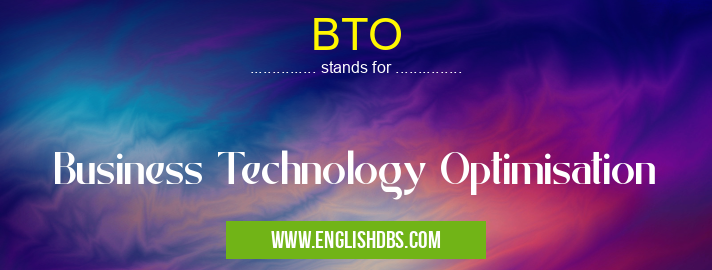What does BTO mean in GENERAL
Business Technology Optimization (BTO) is an approach to business management and IT implementation that helps organizations maximize their investment in technology and improve the efficiency of operations. It focuses on optimizing existing infrastructure, processes, and people to ensure optimal use of resources and leverage opportunities for greater success. BTO is often used in conjunction with Enterprise Resource Planning (ERP) software platforms, allowing organizations to manage enterprise environments more efficiently and effectively.

BTO meaning in General in Business
BTO mostly used in an acronym General in Category Business that means Business Technology Optimisation
Shorthand: BTO,
Full Form: Business Technology Optimisation
For more information of "Business Technology Optimisation", see the section below.
What BTO Means
At its core, BTO is a strategy focused on making sure existing technology investments are maximized for success. Organizations use this approach to understand the current state of their infrastructure, applications, processes, users, and other relevant data sources. This helps them identify gaps between current capabilities and desired outcomes. After understanding these gaps, they can prioritize initiatives that will bridge those gaps most quickly or deliver the greatest value. Solutions may include changes to business processes or technology implementations such as cloud computing or automation technologies. Additionally, organizations may also need to make organizational changes such as reallocation of personnel or skillsets in order to take advantage of new opportunities created by technology adoption.
Benefits Of BTO
The main benefit of a BTO approach is the ability for faster decision-making in an ever-changing digital landscape. By gathering all relevant data points into one system that everyone can access and review quickly, organizations can reduce time spent on manual analysis or fruitless discussions about what should be done in order to reach a certain goal. Additionally, this method allows businesses to focus their resources more closely on high-value initiatives that have a real chance of positively impacting desired outcomes. The improved visibility also helps companies identify areas where improvements are needed much quicker than before so they can act proactively instead of waiting until it’s too late to go back and fix problems.
Essential Questions and Answers on Business Technology Optimisation in "BUSINESS»GENERALBUS"
What is Business Technology Optimisation?
Business Technology Optimisation (BTO) is the process of optimising and managing the use of technology in a business environment to facilitate operations, improve productivity, reduce costs and increase profits. BTO seeks to create an effective collaboration between technology and business processes in order to achieve the desired results.
How does BTO work?
BTO works by analysing existing business systems and processes, identifying areas for improvement, evaluating potential solutions and making changes where necessary. The aim of this process is to increase operational efficiency, lower costs and ensure that the most appropriate technologies are being used.
What are some examples of technologies used in BTO?
Examples of technologies used in BTO include cloud computing, mobile applications, analytics tools, artificial intelligence (AI), machine learning (ML), robotic process automation (RPA), blockchain technology and internet of things (IoT).
What are the benefits of implementing BTO?
Implementing Business Technology Optimisation can help businesses significantly improve their competitive edge by creating new opportunities for innovation as well as boosting operational efficiency. Additionally, lower technology costs can be achieved using this approach while also gaining better insight into customer needs and improving customer service.
How long does it take to implement a successful BTO strategy?
Implementing a successful Business Technology Optimisation strategy can take anywhere from months to years depending on the complexity of the project. Factors such as size and scope may also affect how long it takes to complete a project successfully.
Who should be involved in designing a successful BTO strategy?
A variety of stakeholders should be involved when designing a successful BTO strategy including IT personnel, senior managers, business analysts, technical developers and financial experts among others. They will work together in order to make sure that all aspects of the projectare taken into account when planning for success.
Are there any risks associated with implementing BTO?
Yes there are always risks associated with implementing any new technology or process however these risks can typically be mitigated through proper assessment and planning before implementation takes place. It is important to weigh up all potential risks against any potential rewards before rolling out any new changes.
Is it necessary for businesses to invest heavily in technological solutions when addressing challenges using BTO?
Not necessarily - while technological solutions may form part of an overall solution they are not always required in order to address issues with Business Technology Optimisation strategies. Many strategies often make use of processes which seek to improve existing systems that are already in place without necessarily investing further funds into new hardware or software solutions.
Final Words:
Business Technology Optimisation provides a valuable strategy for organisations attempting to maximize their tech investments while ensuring their processes keep up with customer needs and industry trends. By taking into account user behaviour, preferences and existing data points as well as emerging tools such as cloud computingand automation technologies - organisations are better able simplify decision-making process while boosting operational efficiencies across departments.
BTO also stands for: |
|
| All stands for BTO |
